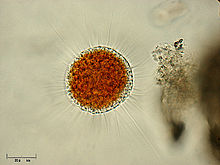| Vampyrellida | |
|---|---|

| |
| Vampyrella lateritia | |
| Scientific classification | |
| Domain: | Eukaryota |
| Clade: | Diaphoretickes |
| Clade: | SAR |
| Phylum: | Endomyxa |
| Class: | Vampyrellidea Cavalier-Smith 2018[2] |
| Order: | Vampyrellida West 1901, emend. Hess et al. 2012[1] |
| Clades[3] | |
| Diversity[3] | |
| 48 species | |
| Synonyms[4] | |
|
Aconchulinida De Saedeleer 1934 | |
The vampyrellids (order Vampyrellida, class Vampyrellidea), colloquially known as vampire amoebae, are a group of free-living predatory amoebae classified as part of the lineage Endomyxa. They are distinguished from other groups of amoebae by their irregular cell shape with propensity to fuse and split like plasmodial organisms, and their life cycle with a digestive cyst stage that digests the gathered food. They appear worldwide in marine, brackish, freshwater and soil habitats. They are important predators of an enormous variety of microscopic organisms, from algae to fungi and animals.[3] They are also known as aconchulinid amoebae (order Aconchulinida).[4]
- ^ Cite error: The named reference
Shedding light on vampireswas invoked but never defined (see the help page). - ^ Cite error: The named reference
MultigeneRhizaria2018was invoked but never defined (see the help page). - ^ a b c Cite error: The named reference
Vampyrellid Amoebaewas invoked but never defined (see the help page). - ^ a b Cite error: The named reference
Adl 2019was invoked but never defined (see the help page).